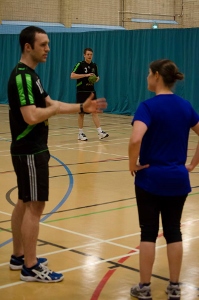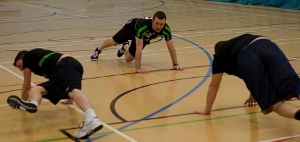How to Get Fit for Handball pt1
6 CommentsHandball is the second most popular team sport in Europe
Since London 2012, the number of clubs in England has nearly doubled. It is one of the country’s fastest growing sports, with total participation increasing by 400% in the last three years. Handball fitness is unique.
Several years ago I trained one of the GB team: Emma Solomon, (before they went with “Talented and Tall” and look how that worked out!) when Handball was very much a minority sport.
Here Matt goes through the basic requirements of Handball and then how to train for it.
Basic Rules of Handball
Handball is a fast paced, high scoring game played by two teams of 7 players (6 court players + 1 goalkeeper) over two 30 minute halves. The match is won by the team who can score the most goals by throwing the ball past the opposition goalkeeper into the net.
- Handball is played on a court measuring 40m x 20m with a goal (3m x2m) at each end.
- The ball is moved about the court by dribbling (similar to basketball) or passing to a team mate.
- Once in possession of the ball, a player has 3 seconds and/or 3 steps before they must pass, shoot or dribble the ball.
- As in basketball, once a player has stopped dribbling they must either pass or shoot.
- Only the goalkeeper is allowed within the 6 metre goal area* (free throw if attacker enters, penalty throw if defender enters.* Player can jump into area whilst shooting as long as ball is released before ground contact)
- Players can use the torso to block an opposing player, but obstructing, tripping, hitting or pushing using outstretched arms or legs will result in free throw (or penalty throw if a clear goalscoring chance is denied)
Handball Fitness Requirements
Similar to most team sports, there are different positions within a Handball team including:
- Goalkeeper
- Backcourt players (left, right and centre)
- Wingers (left and right)
- Pivot.
Although players in different positions will have slightly different characteristics, most players (goalkeepers aside) will do a similar amount of work, both defensive and offensive, within a game.
Indeed, a study by Chaouachi et al., (2009) found that there was no significant difference in performance abilities (speed, bilateral and unilateral jump distance, VO2 max) between positions.
Due to consecutive end- to-end attacks, speed is a vital asset for all handball players. The ability to attack the opposition goal before the defence has time to organise itself greatly increases the chances of scoring.
As well as straight line speed, changing direction at speed is also an important skill. Players with agility can create and find space to produce a shooting opportunity, and also ensure opposition players cannot outmanoeuvre them when defending.
Upper and lower body strength and power also come in useful when shooting, especially jump shots which are a common technique for avoiding defenders trying to block.
Although a handball game last for an hour, each team has 7 substitutes, with an unlimited amount of changes allowed. This means that work capacity is less important than in other team sports, as players can be rested regularly.
Players still need to be well conditioned to allow for repeated work of high quality in training. More time should be spent on developing the quality of movement to produce fast, strong and agile players.
How to get fit for Handball
Strength training is important for all handball players for both injury prevention and improving performance.
The one sided nature of handball can lead to muscle imbalances, so shoulder, back and hip mobility and unilateral strength need to be included regular in training plan to maintain structural integrity.
Lower body strength and stability are also vital to reduce injuries due to the high impact and regular changes in direction. The risk of injury is especially high for female players.
Strength training will also benefit performance by providing more power for shots and helping to jump higher to compete for the ball. Having a strong upper body also comes in very useful when defending.
A common tactic of defending is to pull the throwing arm of the attacker down (although resulting in a free throw, attacking team often gets no little advantage from this).
This requires good shoulder strength and stability, potentially through a great range of movement as attackers often take shots from high, low and wide positions. Click here for tips on Strength Training.
Speed and Agility for Handball

Emma Solomon captained her GB team,.
Speed and Agility training should build on a foundation of:
- posture
- balance
- mobility
- control
Practising exercises such as single leg squats and single leg hop and holds will increase lower body strength and improve the body’s ability to reduce force. This will make movements more efficient and reduce likelihood of injury.
Working on force production (acceleration, propulsion on different directions) should follow once a strong and stable base has been set.
This should include varying movements such as pushing off 2 feet and one foot in forward, sideways and backward directions to simulate to demands of a handball game.
These skills can then be progressed to become more complex and reactive, see here.
Although handball is characterised by repeated sprints over a short distance, improving maximal running speed will also help acceleration and speed over short distances.
Once the quality of these movements has been established, then the quantity of work can be increased to improve work capacity and ensure that a high level of performance can be maintained for the duration of a match.
Summary
Handball is one of the country’s fastest growing sports. Playing requires speed and agility, which should be developed through a progressive programme starting with strength, stability and balance.
Once a strong foundation has been built, acceleration, speed and reactive drills will enable the player to develop key skills to perform successfully.
Putting this into practice is difficult for a coach, so here are my tips on Handball training in practice.
Matt Durber
Further reading:
How to make pre season training interesting, relevant and more fun.
References
- Chaouachi A, Brughelli M, Levin G, Boudhina N,B, Cronin J & Chamari K (2009). Anthropometric, physiological and performance characteristics of elite team-handball players, Journal of Sports Sciences, 27 (2), 151-157.


 When planning the ideal training schedule of a Handball team, I would probably include 2 or 3 team technical/tactical sessions, a couple of gym based strength sessions and a court based agility or speed session. However, like many amateur sports teams around the country, the Handball players I coach only train together once a week.
When planning the ideal training schedule of a Handball team, I would probably include 2 or 3 team technical/tactical sessions, a couple of gym based strength sessions and a court based agility or speed session. However, like many amateur sports teams around the country, the Handball players I coach only train together once a week. I recently completed my Handball Level 2 coaching certificate, which gave me the opportunity to meet fellow Handball coaches, who hailed from various backgrounds.
I recently completed my Handball Level 2 coaching certificate, which gave me the opportunity to meet fellow Handball coaches, who hailed from various backgrounds.